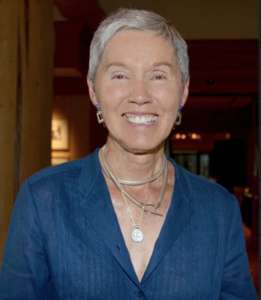Get to know fourth president Janet DeBard
by emily jones
 Supporting the arts, education, health and social service sectors have long been priorities for past Wood River Women’s Foundation President Janet DeBard (2013-2015).
Supporting the arts, education, health and social service sectors have long been priorities for past Wood River Women’s Foundation President Janet DeBard (2013-2015).
A native of St. Joseph, Michigan, DeBard received her Master’s in Inner City Education from Case Western Reserve University and Doctoral Studies in Education from UCLA. She first became involved in philanthropy and the arts as a young adult living in Pacific Palisades, California.
Just over 23 years ago, DeBard and her husband, Roger, moved from L.A. to Ketchum, where they made their home for two decades. The couple recently moved to Montecito, California, but has maintained their grant support to a variety of Blaine County nonprofits, including The Community Library, The Hunger Coalition and St. Luke’s, where Roger serves as Chair of the Foundation Finance Committee.
DeBard remains involved with WRWF through service on the President’s Council, an advisory arm to the WRWF Board, and the 2022 WRWF Focus Grant Committee, whose task is to review nonprofit applications that support programs to close the opportunity gap in education. This is the first ever $100,000 grant offered by WRWF.
In addition to her presidential role, DeBard chaired WRWF’s Grants and Nomination committees and served as an editor for the organization’s monthly News Brief.
Keep on reading to learn more on her background, what the foundation was like when she was president and what she believes her contributions were.
Q: How did you find your way to the Wood River Valley?
A: It was a spur-of-the-moment holiday trip around Christmastime some 20 years ago. We arrived in Sun Valley from L.A., never having visited, and fell in love with it instantly—the beauty, the fun atmosphere, the rich community offerings. By the end of the week, we had purchased a home! Initially, we were part-time, but within a few years we became full-time residents of Ketchum.
Q: What are some of your accomplishments as president?
A: During my term as president, our membership went from around 100 to 200 members. I encouraged efficient functioning of the board as well as a strong committee structure, resulting in strategic planning and greater member involvement. I believe encouraging members to become involved was a factor in their reaching out to attract others to join WRWF.
Q: It sounds like this growth was very visible. How did you create more structure to accommodate a larger organization?
A: Let me backup for a moment. When I was the Grants Chair, I streamlined the process so that there would be division of workload and a process that could clearly be passed to future Grants Chairs. These procedures have held, with some appropriate iterations, allowing our grants process to involve many members and arrive at a slate of strong finalists each year for the membership vote.
As president, my goal was to strengthen the WRWF board functioning. First, each Chair was tasked with defining her job description. Next, I instituted the consent agenda, asking for the work of each committee chair to be submitted before each board meeting, thus saving valuable board time for new business. This, along with asking each chair to form a strong committee, led to increased membership involvement—which, in turn, led to a rise in membership.
I also reformatted the News Brief to be a more appealing source of WRWF information by incorporating more visuals with brief articles. Readership went up.
After my presidency, I chaired the Nomination Committee. We realized the need to connect specific board openings with women who had relevant experience. The Board would recommend some members, and other members would submit their interest in joining. We would then recruit those who possessed the skill sets we presently needed.
Q: Going forward, how do you think the organization can attract younger members?
A: A lot of our membership does give generously to many causes, but there are also members where this is the capacity of their gifting for the year. With a WRWF membership, the impact on the community is multiplied by 300 members. One thing that I suggested to the board after speaking with a young member was a “50/50” concept where you could give half of the membership fee until you turn 50, encouraging younger women to participate. That idea later came to fruition in the “Future Forward” program.
Q: Together with your husband, Roger, you created the DeBard Johnson Foundation. Can you talk a bit about the foundation’s mission?
A: We have five funding categories, but education, health, social service and the arts are our main focus. We involve the whole family with grantmaking—our daughter, her husband and their two children. Our grandsons, who are 14 and 18 now, started to join our annual meetings about 3 years ago. Today the six of us have a seat at the table and make recommendations for causes to support. Our 14-year-old grandson is interested in health and social services and has donated to a food-bank program in Connecticut, similar to the Hunger Coalition; our 18-year-old grandson is very interested in environmental health and has donated to The National Outdoor Leadership School and a disaster relief program.
Q: What are some pastimes you enjoy?
A: I’ve enjoyed many art forms in my adult life: fabric design, jewelry design, painting, monoprinting, and presently, collage art and composing poetry. I’ve noticed there seems to be about a 10-year cycle before I transition to a new medium. I have no formal training in the arts, but it’s fun and challenging to delve into new forms of expression. Our family always embraced Sun Valley’s outdoor offerings – hiking, biking, cross-country skiing. We continue to enjoy the outdoors in California.
Contact Us
Get Involved
Resources
News Briefs
DONATE TODAY
@2024 Wood River Women’s Foundation
Tax-Exempt 501(c)(3) Federal Tax ID #81-4000190
Website By: Studio 360 Design